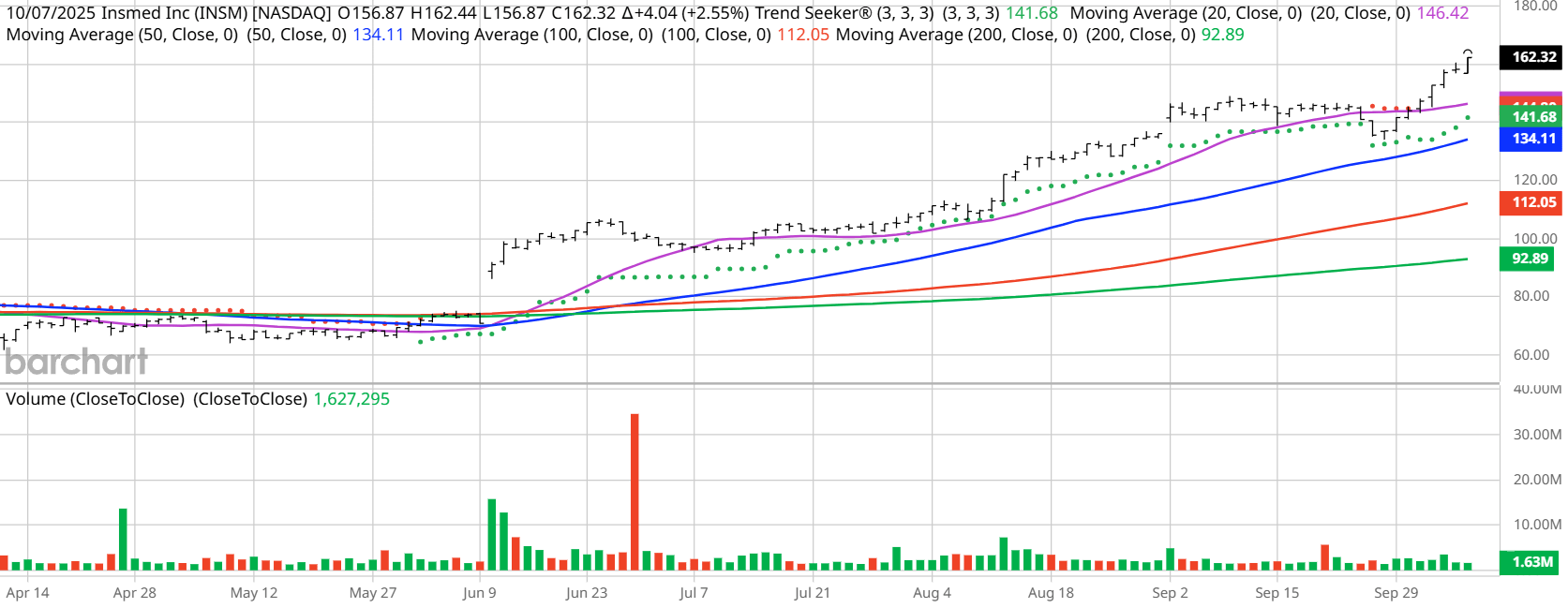
- Insmed (INSM) is a biopharmaceutical company with strong momentum.
- Shares are trading at new 20-year highs.
- INSM has surged 128% over the past year.
- Analysts expect robust revenue and earnings growth, but opinions are mixed, with some cautioning the stock is overvalued.
Today’s Featured Stock
Valued at $34.3 billion, Insmed (INSM) is a biopharmaceutical company engaged in the development and commercialization of ARIKAYCE, a treatment for rare lung conditions.
Insmed is also focused on the development of INS1009, an inhaled treatment for pulmonary arterial hypertension (PAH), a chronic, life-threatening disorder characterized by abnormally high blood pressure in the arteries between the heart and lungs.
What I’m Watching
I found today’s Chart of the Day by using Barchart’s powerful screening functions to sort for stocks with the highest technical buy signals; superior current momentum in both strength and direction; and a Trend Seeker “buy” signal. I then used Barchart’s Flipcharts feature to review the charts for consistent price appreciation. INSM checks those boxes. Since the Trend Seeker signaled a new “Buy” on Oct. 1, the stock has gained 10.12%.
INSM Price vs. Daily Moving Averages:

Barchart Technical Indicators for Insmed
Editor’s Note: The technical indicators below are updated live during the session every 20 minutes and can therefore change each day as the market fluctuates. The indicator numbers shown below therefore may not match what you see live on the Barchart.com website when you read this report. These technical indicators form the Barchart Opinion on a particular stock.
INSM hit a 20-year high of $162.80 in morning trading on Oct. 8.
- INSM has a Weighted Alpha of +126.78.
- Insmed has an 100% “Buy” opinion from Barchart.
- The stock gained 127.29% over the past year.
- Insmed has its Trend Seeker “Buy” signal intact.
- INSM has made 6 new highs and gained 10.59% in the last month.
- Relative Strength Index (RSI) is at 76.32.
- There’s a technical support level around $158.60.
Don’t Forget the Fundamentals
- $34.3 billion market capitalization.
- Revenue is projected to grow 29.95% this year and another 124.91% next year.
- Earnings are estimated to increase by 0.62% this year and an additional 34.92% next year.
Analyst and Investor Sentiment on Insmed
I don’t buy stocks because everyone else is buying, but I do realize that if major firms and investors are dumping stock, it’s hard to make money swimming against the tide.
It looks like Wall Street analysts have positive opinions on INSM, but Value Line is very cautious.
- The Wall Street analysts tracked by Barchart have issued 17 “Strong Buy,” 1 “Moderate Buy” and 2 “Hold” opinions on the stock with price targets between $138 and $240, a very wide range.
- Value Line gives the stock its “Lowest” rating with a price target of $162.
- CFRA’s MarketScope Advisor rates it a “Hold.”
- Morningstar thinks the stock is 30% overvalued.
- 352 investors following the stock on Motley Fool think the stock will beat the market while 108 think it won’t.
- 1,370 investors monitor the stock on Seeking Alpha, which rates the stock a “Hold" and comments: “The company’s diversified pipeline, including promising assets like TPIP, reduces reliance on a single product and enhances long-term growth prospects, supported by a substantial cash reserve.”
The Bottom Line on Insmed
Analysts project growth in revenue and earnings for Insmed, and the company has a solid following by Wall Street analysts. Investors should note the stock’s volatility and employ disciplined risk management.
Today’s Chart of the Day was written by Jim Van Meerten. Read previous editions of the daily newsletter here.
Additional disclosure: The Barchart of the Day highlights stocks that are experiencing exceptional current price appreciation. They are not intended to be buy recommendations as these stocks are extremely volatile and speculative. Should you decide to add one of these stocks to your investment portfolio it is highly suggested you follow a predetermined diversification and moving stop loss discipline that is consistent with your personal investment risk tolerance.







